Four people, two wheelchairs — back-to-back atmospheric rivers on the way — those were just some of Frank Ploof’s concerns Saturday, January 20, as he piloted his 2001 Chevy truck through and around the potholes dotting the road that took him to people he sometimes refers to as the “deep homeless” — individuals and couples who’d been on the streets for years and most everyone had given up on. Overhead, dark clouds threatened rain.
Ploof was especially worried about Shonnia, a disabled woman he had last seen alongside the same bad road a day earlier. At that time, she was under a pile of blankets and belongings that hid her and her wheelchair so well he hadn’t known she was there.
Ploof had been keeping track of Shonnia since 2017, when she was among several people with nowhere to go after the building she was living in was condemned by officials from the City of Modesto. He’d tracked her from a permitted campsite at the Modesto Outdoor Emergency Shelter (MOES) to substandard apartments, to the streets and back again, often losing touch only to find her again. It’s a common pattern among the deep homeless, especially since Stanislaus County and the City of Modesto have implemented their “accountability” program, which consists mainly of forcing them to move on from whatever places they might find to sleep or rest.
The sweeps and “move along” tactics make it even more difficult for volunteers like Ploof* to track and help people whose ailments and illnesses need almost constant attention and monitoring. Averse to shelters and generally suspicious of officials, the deep homeless often have good reasons for preferring life on the streets.
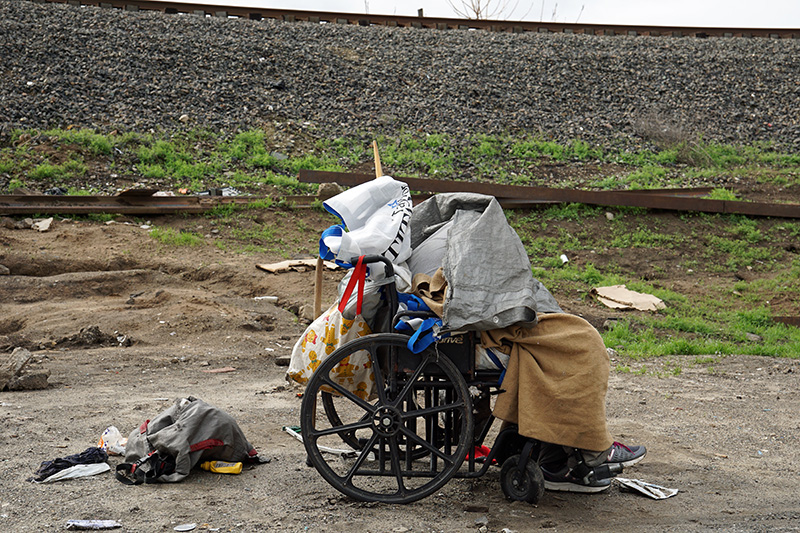
Some have been shaken down and robbed while staying at shelters. Others resent the lectures and proselytizing. Still others become claustrophobic and restless after too long a stay in crowded, barracks-like facilities. They know that a stay at a shelter can easily last years, especially given our severe housing shortages.
Many have been through shelters and found that service providers are overburdened and the labyrinthine process for qualifying for assistance isn’t only exhausting, it rarely results in action. They’re mistrustful of authorities because they’ve found that promises of help too often result in bureaucratic impasse.
Generally dressed like a typical suburban senior on his way to the hardware store for a can of paint or sprinkler head, Frank Ploof’s casual appearance offers a reassuring presence to homeless people who’ve given up on officials. He’s a shorts and pullovers guy except when inclement weather forces him into a windbreaker and long pants. His encyclopedic knowledge of local systems of care includes the hard-earned wisdom that most lack the capacity to handle even a small fraction of homeless people’s needs.
Because he stays in touch with dozens of them, the deep homeless know that Ploof is more friend than official; that’s why they’re likely to call on him instead of authorities. It’s also how Ploof learned that a friend was willing to take Shonnia and her partner in, at least during the winter months. Shonnia’s friend asked Ploof if he could transport a bed and the couple’s belongings to the residence, which was several miles from the industrial back road where Shonnia and Mike had been living under a tarp attached to a chain link fence.
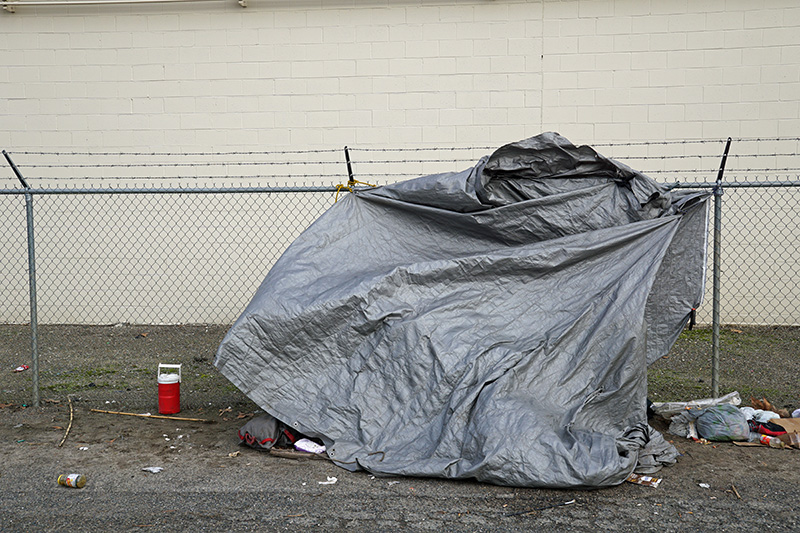
Since he’d already been working with a man and woman camped nearby, Ploof readily agreed to help. He figured he could get the two other campers and their belongings to a local shelter even while helping Shonnia and Mike. He knew he had to act fast in both cases because people on the streets frequently change their minds about going in, often because it involves filling out lengthy forms, answering humiliating questions, and long delays.
As always, there were problems. The bed had to be transported across town; it was heavy and in bad condition. After collecting Shonnia’s and Mike’s belongings, Mike told Ploof that Shonnia could not be transported except by a vehicle with a chair lift; she was too disabled to get in and out of a truck or car. Mike assured Ploof he could push Shonnia to a bus stop, even though his own legs were so bad he too needed a wheelchair much of the time. He walked only haltingly and with the use of a cane.
Ploof’s schedule was getting crowded. He’d already been working with the two other campers to get their belongings moved, get them on the list for entry into a local shelter, and get them health care. One had cancer, the other serious health problems of his own.

“We need one of those giant medical tents they use during disasters,” said Ploof, reflecting on how many seriously ill and disabled people are among the homeless population. “A lot of the homeless problem is caused by breakdowns in our health care system.”
One such breakdown made local headlines a few days later when the owner of a Turlock nursing home announced it would be closing. According to the Modesto Bee,
Closure of the 145-bed Brandel Manor will eliminate 30% of the nursing home beds in Turlock, which threatens to create a dire shortage of those services in southern Stanislaus County.
While Ploof was dismayed by the news about the nursing home, he wasn’t disheartened. After over a decade working with homeless people, Ploof had no illusions to lose about the lack of services for the ill and disabled. That was the major reason he had signed Shonnia and Mike up for a new enhanced health care program. He wanted to test whether the new program might actually help Shonnia where other options had failed.
“It’s not enough to get someone inside or in the hospital,” said Ploof. “With many homeless people there’s a need for further care. They won’t be able to stay housed without monitoring and help and the hospitals just put them back on the street.”
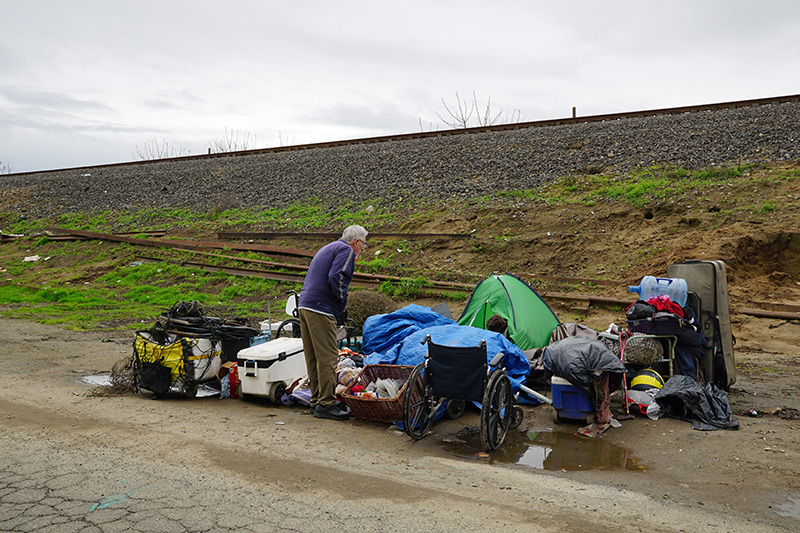
Ploof’s busy weekend extended from Saturday into Sunday as yet another disabled couple, Jeff and Lori, had also been told to move along. They’d been living in a small tent with two dogs and a cat, just across the road from Shonnia and Mike. They had belongings they couldn’t carry or move; both also used wheelchairs; they could walk only short distances. After they asked for help, Ploof loaded his truck and hauled their things to a temporary storage location. With nowhere else to go, Jeff and Lori remained in their tent alongside the road, hoping authorities would forget about them. By this time, Ploof’s original mission to help two homeless campers get into a shelter had become a service for six.
By Monday, Ploof assumed Shonnia and Mike had gotten inside and out of the rain. He was stunned to learn someone had seen Mike along the same road he had supposedly left two days earlier. Mike had been standing next to Shonnia’s wheelchair; it was once again piled with tarps, blankets and assorted belongings.
Already busy transporting the two other campers and their belongings to the local shelter and helping them get on the waiting list for entry, Ploof now had to contend with Shonnia’s ongoing plight. Mike had told people that help was on the way, and Ploof hoped it was true. Tuesday, Ploof learned Mike and Shonnia were still in the same place.
“I went out and found them and that was enough. They had been out there during a heavy rainstorm and no one had come along, so I called an ambulance. The paramedics told me they had taken Shonnia in earlier in the month, so it’ll probably be another case of ‘treat and street,’ but at least she’ll get a few days in the hospital for evaluation.”
Two days later, Ploof checked on Shonnia. She was still in the hospital. Always hopeful but rarely optimistic, Ploof was ready to pursue Enhanced Care Management, a new state program.
“Maybe it’ll work,” he said.
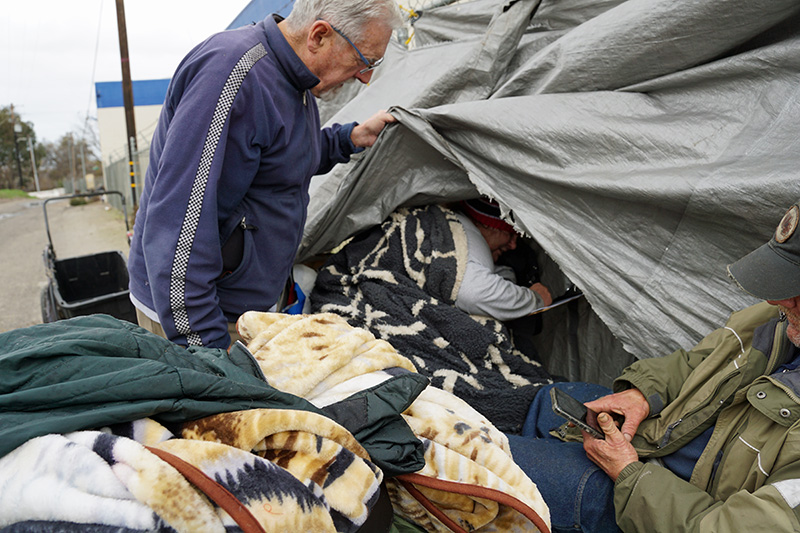
He’d convinced Shonnia and Mike to fill out the required forms, and he was ready to take whatever other measures might get his friends to a better place. In over a decade of practicing humanity among the homeless, Ploof had learned his best allies in his service to the forsaken and forlorn were patience and persistence. If and when there was an open door of any kind, he would be ready to push his homeless friends through it, even if he had to build it himself. Broken systems of care and bureaucratic thickets hadn’t defeated him yet. And, at least for the time being, Shonnia had a place to go when released from the hospital.
Frank Ploof decided his next Saturday would be a day off. He figured he had earned one.
*Frank Ploof is a co-founder and volunteer for Stanislaus Homeless and Advocacy Resource Enterprise (SHARE) a Modesto non-profit that provides material assistance for homeless people.

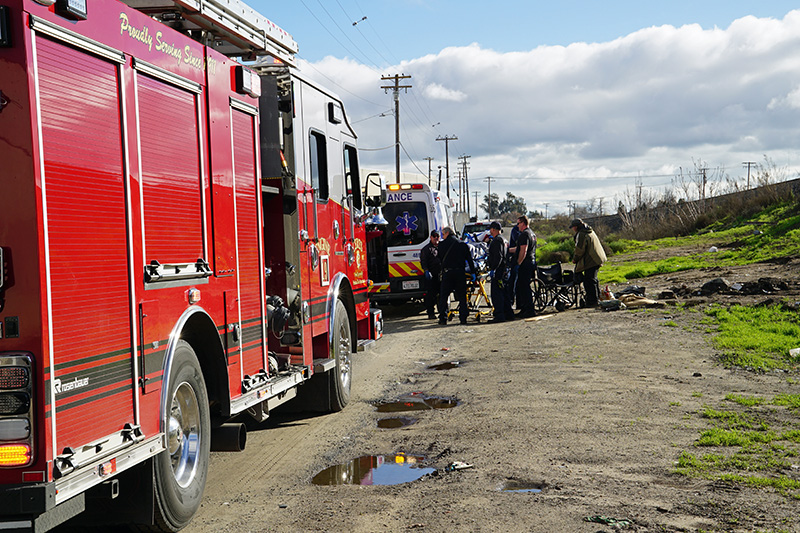
Frank Ploof, you are truly a force to be reckoned with. I commend you for your dedication and perseverance in assisting the unhoused in Modesto.
I miss the days we shared at Beard Brook and MOES, I would have thought that by now a lesson would have been learned regarding what it takes to really make a difference to the homeless community. I still have hope that someday City officials can see the light.
Great article, like always Mr. Caine. And to you Mr. Proof, I wish we had more people like you in our community. And I wish our mayor and her colleagues on the city council, who refuse to understand why we need a safe camping space for our homeless, would spend a day with you on the streets of Modesto to learn why we need a safe camping space.
It is heart warming to read articles like these. It shows me that there are humans still here on earth. I was incarcerated in 1998 for 17 years. I paroled in 2016 after almost 18 years. I am a 90s baby so I am still in awe at the lack of empathy and plain humanity that has disappeared. As I write this, I am a mother with three small children, ages one, three, and six. I have reached out to every one listed on the Solano County Homeless Resource page and even local churches. So far I received help with a half pack of diapers and some gently worn clothes. Please don’t take it as if I am unappreciative because that donation has helped. I was told by Cal Works that they have ” nothing for me.” I have ripped off deep scabs and opened up wounds to complete the intake process to nowhere. How can one live in a world so devoid of humanity especially when one is in the very industry that provides for homeless assistance? Waiting on the world to change, waiting on the world to care…
1981 birth year does not make a 90s baby, and 3 kids and homeless is heartless .Are you living in a car?
[…] Story continues […]
[…] Story continues […]
Between Eric Caine and Bambi Boyer, you both made poignant remarks that evoked a genuine capture of how, much too often, the system, as it exists presently, is devoid of making much sense. An overhaul, designed by people with compassion, is long overdue.
As for Frank Ploof, I am certain many are impressed with his goodwill towards fellow mankind sunk deep into Modesto’s systemic homelessness rackett. A simple thank you does not even begin to touch the surface of all Frank and SHARE do.
Zaff Solomon, continue shining the light on what those without homes need: safe camping grounds. Legally, the Mayor and her council should be curtailed from moving people from one spot to another. Their behavior has been unlawful, even if the legal authorities are used in the commission of their crimes against the poor.
Jerry Matoza, you are so right. The rest of Modesto’s NIMBY’s ought to have learned the lesson that they MUST provide safe, legal ground, other than shelters, since public and private space is off limits. It is not like those needing space to exist can levitate.
I continue to advocate for Modesto to be embroiled in a court battle for the sake of our homeless. Hundreds, if not thousands of people existing out in the open, all around, inside Modesto should not have to contend for the one or two shelter beds that may or may not be available on any given 24 hour day. May the Mayor have mercy on their tired, weary, wet bodies.
We should not have to learn of any deaths of our homeless because of a stingy city.
Just turn and look away, they are there because they want to be, is what many think and say.
They all didn’t get there on their own, welfare, drugs allowed to pour in this country for years!
then one day I, noticed the homeless didn’t look as before and they looked to me as they were walking dead and their appearance was far worse than ever before and I think back to the days they ended welfare as we knew it!
People got cut off and kicked out of homes. The Hobos of days gone past no longer lived by railroad tracks.
Our state of California keeps supplying everything they need to stay homeless and yes there are those that can’t or won’t except help because they mentality cannot and help they really need never happens. Year 2024 with current government there is a promise of more of us on the streets of America 🇺🇸 and just a matter of when God bless those that get involved to make a difference in the lives of down and out Americans and we all could step up.
wheels kmc
Frank Ploof: Practicing Humanity among the Homeless